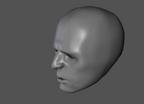|
|
 |
|
Spline + Subdivision Head Modeling Added on: Sat Aug 30 2003 |
| Page: 1 2 3 4 |
This is a modeling method I have been using for some time now. I try to combine the caging and visualization strengths of spline modeling with the maneuverability and interactivity of polygon modeling in 3D Studio Max 5. The strategy here is to go from general to specific when approaching a human head In Max.
 
 
There are many head modeling tutorials on the net that guide you through every single step. This is more of a theory tutorial for people who already know how to use the basic 3D Studio Max tools and want to try a new way to do their models.
First we draw the profile of the head. Keep it simple and low poly, with corner vertices only, since we are only going to use the spline surface as a starting point. You might want to put images of both front and side views of the head on planes in the viewports as reference, but I rather work without it and just look at the reference pictures in a separate window, so that I don�t have too much going on in the viewports.

Now draw the eyes, mouth, nose bridge and cheekbone lines, like the picture below shows. It may be better to do this in the perspective view, and then go to the front view to align the vertices. Make sure you use the keyboard shortcut �S� as you do this, to turn vertex snap on/off when starting your lines.

|
 |
|
|







